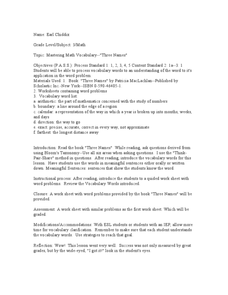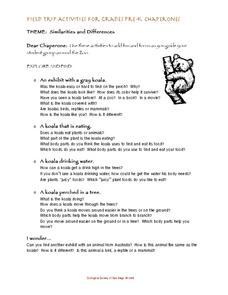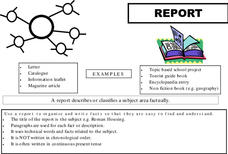Curated OER
Berlioz the Bear
Young children read the story, Berlioz the Bear and complete various reading and writing activities. They learn about fiction and non-fiction, and complete graphing and writing activities for the story. Youngsters draw the bear and use...
Curated OER
three Names Lesson
After the book Three Names is read aloud, math vocabulary is introduced . Either alone or in groups, learners use the vocabulary words in a meaningful sentence. Then they complete the provided worksheet.
Curated OER
The Power of Mental Images: Visualizing Literature
Looking for a powerful reading comprehension method? Try visualization! Learners use this strategy to increase comprehension of a chapter book selected by the teacher. As an assessment, individuals or small groups draw pictures of the...
Curated OER
Reading Rainbow
Beginning readers observe and demonstrate a variety of reading expression strategies. They listen to the teacher read the book Ten Hungry Monsters both with and without expression, and discuss the difference. Then it's their turn!...
Curated OER
Elementary Economics:Making Smart Choices
Pupils understand what good and bad choices are in regards to money and review and reinforce the value of each coin. They identify parts of a story as well as the sequencing. They then create their own sequence of events in words and/or...
Curated OER
Coming Home:From the Life of Langston Hughes
Third graders listen to the non-fiction book: COMING HOME: FROM THE LIFE OF LANGSTON HUGHES. They identify examples of metaphors and similies within the book and understand how this figure of speech is used in writing. They then create...
Curated OER
Similarities and Differences
Students complete pre-visit and post-visit activities about the koalas they see at the zoo. In this koalas lesson plan, students read books, and answer questions about the similarities and differences they see when they observe the koala...
Curated OER
Presenting Your Case
Students write letter from historical figure's point of view using proper letter writing conventions, write about two props/artifacts that are representative of their subject's life, and use Internet resources to gather images to use in...
Curated OER
Fairytales for 4th Grade
Students read different versions of the Three Little Pigs and then hold a trial for the Wolf. They create a Venn diagram to show the likenesses and differences and engage in a poster making activity to advertise the books.
Curated OER
K-W-L Chart
After choosing a topic of interest, young learners use the K-W-L thinking process to create an informational, illustrated, big book. K-W-L, a three-part thinking process, asks the learner to respond to three questions: What do we know...
Curated OER
The Boy Who Cried Wolf
Second graders listen to the story, THE BOY WHO CRIED WOLF and in pairs, discuss the theme of the book and two things that they liked about it. They then read the book OOPS and discuss the theme of the book identifying the things they...
Curated OER
All Aboard
Explore the U.S.S. Nevada. Researchers use primary sources, secondary sources, children's books and websites to study the naval ship. Their study commences with a class alphabet book on the ship. Intended to be part of a lesson plan on...
Curated OER
Anno's Mysterious Multiplying Jar
Upper graders write word problems and research the uses of multiplication. They start off by taking a pre-test on multiplication and then read the book, Anno's Mysterious Multiplying Jar. They make up word problems to go with their...
Curated OER
Non Fiction Posters
A set of very useful posters (in PDF) describing different types of non-fiction texts is here for you. While there isn't an activity, per se, in these worksheets, they could be used as a handy reference for learners who are engaging in...
Curated OER
Special Places in Our Community
Young scholars compare and contrast cities whether they are large or small, rural or urban. They use digital photography to take pictures of the different types of cities.
Curated OER
Let's Learn About the Fire Station!
Students study and write about the fire station and fire safety. They take photographs to create a page for a class book after visiting a fire station.
Curated OER
Interpreting Data from Birdfeeders
What kinds of birds live in your area? Read a book about birds to your learners and explore their feeding patterns. Charts and graphs are provided in this three page packet, but consider assigning the basic questions if using with young...
Curated OER
Narrative Writing
Students create new sentences using adverb clauses identified from a book. In this narrative writing lesson, students write new sentences from some of the dependent clauses used in a book read to them by the teacher. Students...
Curated OER
The Power of Mental Images: Visualizing Literature
With a chapter book in hand, readers practice visualizing the events and characters of the story. The lesson plan gives suggestions of novels that are rich in detail to help facilitate the process. Drawings from what they read act as the...
Curated OER
Pirate Treasure Hunt
First graders name the directions North, South, East, and West on a map. They work collaboratively in small groups and create a treasure map using directions as clues.
Curated OER
Atomic Structure
Students explore atomic structure. They observe a video on atomic structure and complete a Venn diagram on the parts of the atom. Students create their own graphic organizer on the parts of the atom using Inspiration software.
Curated OER
Sea Changes: A New England Industry
Students conduct research in order to use primary and secondary sources. They interpret and analyze information from textbooks and nonfiction books for young adults, as well as reference materials, audio and media presentations, oral...
Curated OER
Research Skills: Information Retrieval and Evaluation
Focus on research skills, specifically identifying key words and concepts on a specific topic and evaluating information for relevance and authority. This is part of a multi-step lesson on Ancient Rome; however, it is useful for any...
Curated OER
Perception and Observation
Students use common and unusual objects to make observations of details, design, and functionality. They describe and draw each object while working in small groups. The differences between observation and perception is covered as part...























